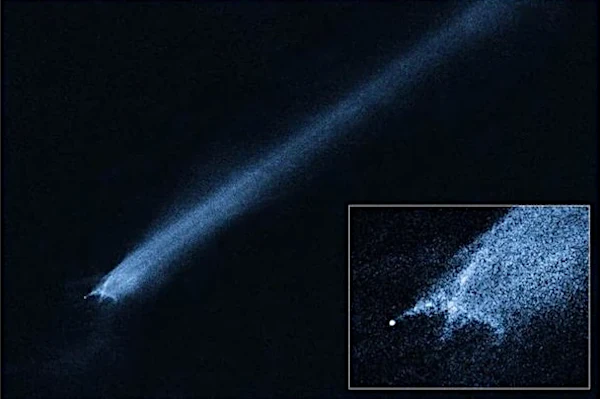
The asteroid P/2010 A2, discovered in January 2010, revealed an unexpected structure, likened to a debris tail, indicating a recent collision within the main asteroid belt located between Mars and Jupiter. Unlike a classic comet, the ejected material is mainly solid, consisting of dust and fragments resulting from a high-energy impact. This event offers a rare case study of mechanical fragmentation in an environment where the relative speeds of bodies are typically on the order of a few km/s.
The collision that originated P/2010 A2 involves a projectile approximately a few meters in diameter striking a larger target body (estimated at ~120 meters). The estimated impact speed in the average asteroid belt is about 5 km/s, leading to a tremendous release of kinetic energy, calculable by: \( E = \frac{1}{2} m v^2 \)
where \(m\) is the mass of the projectile and \(v\) is the impact velocity. This energy causes catastrophic fragmentation of the rocky material through the transmission of shock waves. The ejected debris then follows distinct orbital trajectories influenced by local gravity and solar radiation pressure.
Observations by the Hubble telescope allowed tracing the shape and evolution of the dust tail, which does not follow a classic cometary trajectory (ionized gases), but rather that of solid grains subject to solar radiation force (\(F_{rad}\)) and solar gravity (\(F_{grav}\)). The dynamics of the grains can be modeled by the parameter \(\beta\), defined as the ratio of forces: \( \beta = \frac{F_{rad}}{F_{grav}} \)
with \(\beta\) typically varying between 0.01 and 0.1 depending on the size of the particles (the smaller the particles, the larger \(\beta\)). This analysis allows estimating the size distribution of the debris.
The collision of P/2010 A2 is direct evidence that small, high-energy impacts continue to shape the morphology and dynamics of bodies in the asteroid belt. It also sheds light on the processes of generating interplanetary dust and the renewal of surface material.
| Parameter | Estimated Value | Unit | Remarks |
|---|---|---|---|
| Main body diameter | 120 | m | Estimation from photometry and modeling |
| Projectile diameter | 2-4 | m | Estimation based on kinetic energy |
| Average impact speed | ~5 | km/s | Typical relative speed in the main belt |
| Impact kinetic energy | ≈ 109 | Joules (109 watts in 1 s) | Estimation based on mass and speed |
| Debris parameter \(\beta\) | 0.01 - 0.1 | Dimensionless | Ratio of radiation/gravity forces, depends on grain size |
| Visible observation duration | Several months | — | Window during which the tail was detected |
Sources: Jewitt et al., 2010, ApJ Letters, NASA JPL Small-Body Database.
In an astrophysical context, the probability that a small asteroid (a few meters to a hundred meters) will collide with another similar body in the main belt is extremely low, despite the large total number of objects present. This improbability is explained by the very low spatial density of the bodies and the specific orbital dynamics of the belt. This means that, on average, an object of this size undergoes a collision with another small object about once every 20 million years.
This is why the direct observation of a collision like the one that originated P/2010 A2 is a rare event, but physically plausible on an astronomical timescale, confirming the models of dynamics and evolution of the asteroid belt.